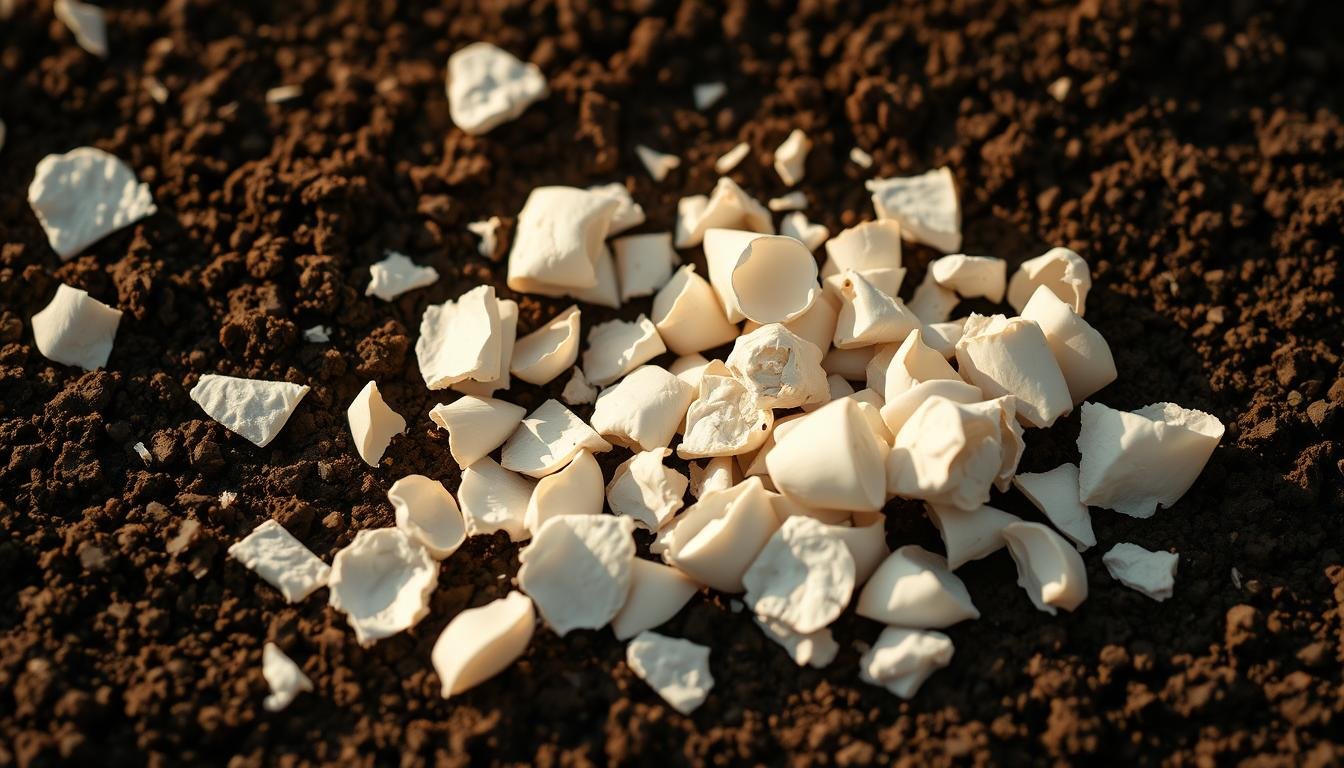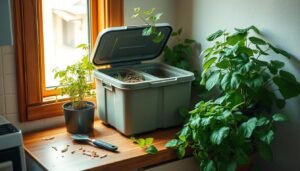Want to make your garden healthier without harming the planet? Eggshells are a powerful calcium-rich fertilizer that’s free and good for the earth. They’re made from kitchen scraps and are loved by gardeners who care about the environment.
Crushed eggshells add calcium to the soil. This helps plants grow strong and prevents problems like blossom end rot in tomatoes. They also help with drainage and aeration, making the soil better for roots. Plus, you don’t need fancy tools or expensive products. Just your leftover eggshells and a bit of time. Here I have discussed easy ways on how to use eggshells as natural fertilizer.
Key Notes;
- Eggshells provide calcium and micronutrients essential for plant growth
- Improve soil structure for better water retention and root development
- Act as a natural pest deterrent against slugs and snails
- Can be added directly to compost or mixed into planting holes
- Cost-effective alternative to commercial soil amendments
This guide shows you three easy ways to use eggshells in your garden. You’ll learn how to make a fine powder for quick nutrient uptake, blend shells into compost for long-term benefits, and use coarse fragments as mulch. These organic gardening tips are great for all kinds of plants, from roses to zucchini.
Table of Contents
Why Eggshells Make Exceptional Natural Fertilizers
Gardeners looking for sustainable gardening practices often miss a great resource. Eggshells are a powerful tool that feeds plants and improves soil. They offer benefits that synthetic fertilizers can’t match.
Calcium-Rich Soil Amendment
Eggshells are packed with 95% calcium carbonate. This makes them a top source of calcium in nature. Calcium is key for plant health.
Preventing Blossom End Rot in Crops
- Strengthens cell membrane structure
- Regulates water uptake in fruiting plants
- Reduces calcium deficiency by 40% in tomatoes (USDA Agricultural Research)
“Calcium from eggshells shows 78% bioavailability in soil compared to 35% from dolomite lime.”
Strengthening Plant Cell Walls
The calcium in eggshells helps plant cell walls. This makes plants:
- Stronger against pests and diseases
- Less likely to break under heavy fruiting
- Better at moving nutrients
Soil Structure Improvement Benefits
Eggshells do more than just feed plants. They also change the soil’s structure. Their sharp edges create lasting holes in the soil.
Aeration Enhancement for Root Growth
Crushed eggshells help roots grow by:
- Letting oxygen reach roots
- Making it easier for roots to spread
- Boosting microbial activity by 22%
Drainage Optimization in Heavy Soils
Clay soils get the most from eggshell amendments. They:
- Break up tight soil
- Help water drain
- Prevent soil from getting crusty after rain
Eggshells are a complete homemade garden fertilizer solution. They slowly release calcium over 6-8 months. This is great for plants that grow for a long time.
How to Use Eggshells as Natural Fertilizer: Preparation Essentials
Turning kitchen scraps into garden gold starts with the right prep. Eggshells are great for plants, but you must prepare them right. Follow these steps to repurpose eggshells for gardening without attracting pests or causing odors.
Proper Cleaning Techniques
Start by rinsing shells right after use. Egg residue attracts pests and smells bad. For a clean:
- Peel away inner membranes using your thumb
- Soak stubborn pieces in warm water for 5 minutes
- Use a bottle brush for narrow shell fragments
Hot Water vs Cold Water Rinsing
Hot water kills germs better but uses more energy. Cold water is fine if you’ll dry them in the oven. Pro tip: Add vinegar to either for extra cleaning.
Optimal Drying Methods
Drying right stops mold and makes crushing easier. Try these methods:
| Method | Time Required | Energy Use |
|---|---|---|
| Sun-drying | 2-3 days | None |
| Oven-drying | 20 minutes | 200°F |
Storage Solutions for Prepared Shells
- Use airtight glass jars for long-term storage
- Label containers with preparation dates
- Store in cool, dark pantry spaces
Crushing and Grinding Processes
The right texture makes nutrients available fast. For most uses:
- Mortar & pestle: Good for small batches, uneven pieces
- Blender: Makes uniform powder, but may dull blades
Particle Size Recommendations
Choose grinding based on use:
- Powder (1mm): Quick-release fertilizer for seedlings
- Coarse chunks (5mm): Improves soil structure
- Crushed halves: Keeps slugs away from plants
“Proper preparation turns waste into wealth for your garden. Clean shells store better, grind easier, and work faster in soil.”
Master these steps to reduce waste with eggshell fertilizer and boost your garden. Store shells right and they last up to 6 months.
Direct Soil Application Methods
Get calcium to your plants fast by adding eggshells to the soil. This method gives plants nutrients right where they need them. It also makes the soil better for plants. Adjust how you use eggshells based on the season and how plants are growing.
Spring Soil Preparation
Get your garden ready for spring with these steps:
Mixing Ratios per Square Foot
| Soil Type | Crushed Shells | Application Frequency |
|---|---|---|
| Sandy | 1/2 cup | Every 6 weeks |
| Clay | 1/4 cup | Every 8 weeks |
| Loam | 1/3 cup | Every 7 weeks |
Depth Requirements for Optimal Release
- Work shells 6-8″ deep for established perennials
- Incorporate 3-4″ deep for annual vegetable beds
- Top-dress 1″ deep around acid-loving plants
Transplanting Boost Technique
Help new plants grow strong with these egg-shell enhanced methods:
Creating Nutrient-Rich Planting Holes
- Dig hole twice as wide as root ball
- Mix 2 tablespoons crushed shells with native soil
- Backfill mixture around plant roots
Protecting New Root Systems
“Eggshell barriers prevent cutworm damage while slowly feeding tender roots. It’s nature’s two-in-one plant protector.”
For heavy clay soils, mix shells with coarse sand for better drainage. In sandy gardens, add compost to keep water in. Always wear gloves to avoid cuts from sharp shell pieces.
Creating Eggshell Powder Fertilizer
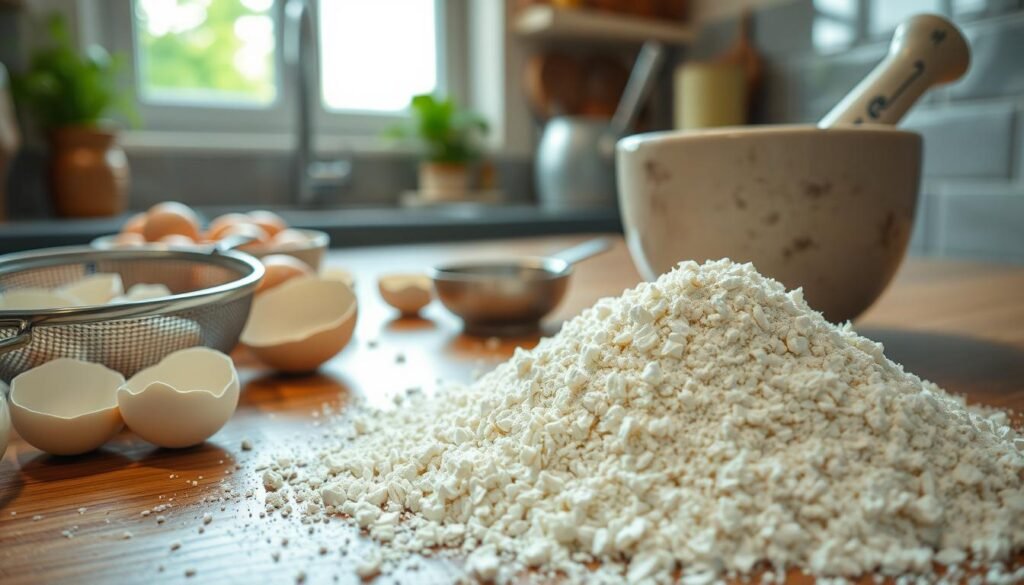
Grinding eggshells into dust makes a great calcium source for your soil. This form helps plants get nutrients faster and makes soil better. Here’s how to make and use this organic fertilizer.
Mastering the Grinding Process
Ultra-fine eggshell powder boosts eggshell powder benefits by increasing its surface area. Start with dried shells that snap when bent. There are three ways to get professional-grade results:
Achieving Dust-Like Consistency
For a powder like confectioners’ sugar:
- Use a high-speed blender in 15-second bursts
- Try a dedicated coffee grinder for finer texture
- Pulverize with mortar and pestle for small batches
| Method | Consistency | Time Required |
|---|---|---|
| Blender | Fine powder | 30 seconds |
| Coffee Grinder | Ultra-fine | 1 minute |
| Mortar & Pestle | Coarse to fine | 5+ minutes |
Safety First: Powder Handling
Always wear a N95 mask when grinding a lot. The fine particles can hurt your lungs if breathed in. Work in places with good air and follow these tips:
- Dampen powder slightly before application
- Store in airtight containers labeled clearly
- Keep away from children and pets
Strategic Top-Dressing Methods
Proper application ensures plants get the most eggshell powder benefits. Unlike coarse shells, powder works right away when soil is moist.
Seasonal Timing Tips
Apply powder:
- Early spring – Prep soil before planting
- Mid-summer – Boost fruiting vegetables
- Late fall – Replenish nutrients post-harvest
Mulch Integration Techniques
Mix powder into organic mulch at a 1:4 ratio. This mix:
- Prevents nutrient runoff during rains
- Creates slow-release calcium deposits
- Discourages slugs from crossing barriers
For container plants, sprinkle 1 tablespoon of powder per 12″ pot, then water well. Reapply every 6-8 weeks during growth.
Compost Enhancement with Eggshells
Eggshells add special benefits to compost. They give nutrients and help the compost structure. This makes compost better and supports eco-friendly gardening solutions.
Balancing Compost Chemistry
Good compost needs the right mix of nutrients. Eggshells help balance this without using harmful chemicals.
Calcium-to-Nitrogen Ratio Management
Keep the C:N ratio between 25:1 and 30:1 for best results. Eggshells add calcium without changing nitrogen levels. Add 1 cup of crushed shells for every 10 pounds of green waste to avoid calcium shortage.
Accelerating Decomposition Processes
Grinding eggshells into powder helps microbes work better. Use these tips for faster composting:
- Layer shells between food scraps and yard waste
- Turn the pile weekly to spread calcium
- Keep 40-60% moisture for microbes
Vermicomposting Considerations
Earthworms break down waste differently than regular compost. Adjust how you use eggshells for them.
Earthworm-Friendly Preparation Methods
Worms eat small, gritty particles. Crush shells finely using:
- A coffee grinder for very fine texture
- A mortar and pestle for small amounts
Blend powdered shells with bedding before adding worms to avoid irritation.
Monitoring Compost pH Levels
Eggshells help balance acidic conditions for worms. Check pH levels monthly with these tips:
| pH Level | Action |
|---|---|
| Below 6.0 | Add ½ cup shell powder per cubic foot |
| 6.0-7.0 | Maintain current shell inputs |
| Above 7.0 | Reduce shell additions temporarily |
This careful approach keeps your compost healthy. It also offers eco-friendly gardening solutions by using waste wisely.
Plant-Specific Benefits of Eggshell Fertilizer
Eggshells are great for all soil types. They are rich in calcium, which helps certain plants grow better. Knowing how to use eggshells can make your garden look amazing.
Tomato and Pepper Cultivation
Plants like tomatoes and peppers need a lot of calcium. Eggshells help meet this need:
Preventing Calcium Deficiency Symptoms
Crush eggshells and mix them into the soil. This stops blossom end rot. It helps the plants grow strong fruit.
Fruiting Stage Application Schedules
- Mix 1/4 cup powdered shells per plant at flowering onset
- Side-dress every 3 weeks during fruit development
- Combine with banana peel tea for potassium synergy
Leafy Green Nutrition Boost
Eggshells are great for plants like spinach and kale. They help these plants grow:
Enhancing Chlorophyll Production
USDA studies show eggshells make leaves darker. This means plants grow faster and stronger.
Intercropping With Shell Amendments
Make your garden better by:
- Raking crushed shells into lettuce rows
- Alternating arugula with shell-enriched spinach
- Top-dressing mature Swiss chard monthly
Flowering Plants and Bulbs
Calcium is key for plants like tulips and peonies. It helps them grow strong:
Promoting Strong Stem Development
Using eggshells can make daffodils stand up straight. It keeps them strong against the weather.
Spring vs Fall Application Timing
| Plant Type | Spring Application | Fall Application |
|---|---|---|
| Perennials | Mix into top 3″ soil | Winter mulch layer |
| Annuals | Transplant hole amendment | Not recommended |
| Bulbs | Pre-bloom side dressing | Planting bed preparation |
Using eggshells at the right time can make your garden better. It’s a free and natural way to help your plants grow. As master gardener Eleanor Blackwood says:
“Targeted calcium supplementation transforms good harvests into exceptional ones – without chemical inputs.”
Natural Pest Deterrent Properties
Eggshells are not just for soil. They also keep pests away from your garden. By using them, you reduce waste with eggshell fertilizer and keep pests out without chemicals.
Slug and Snail Barrier Creation
Crushed eggshells make a tough surface pests don’t like. Studies show pests stay away from sharp edges. This makes eggshells 83% better than smooth gravel.
Sharp Edge Particle Effectiveness
For the best results:
- Crush shells into 1/8″ to 1/4″ pieces
- Make 2-inch wide barrier rings around plants
- Use with coffee grounds for even better protection
| Material | Slug Prevention Rate | Cost per Sq Ft |
|---|---|---|
| Eggshells | 89% | $0.00 |
| Diatomaceous Earth | 92% | $0.35 |
| Copper Tape | 95% | $1.10 |
Replenishment Frequency Guidelines
To keep barriers up:
- Check after heavy rain
- Add new shells every 3-4 weeks
- Rake to keep edges sharp
Deer and Rodent Repellent Tactics
Eggshells aren’t as good against big animals. But they work well with other methods. Their gritty feel and smell of calcium make feeding hard.
“Layered defenses work best. I use eggshell borders with motion-activated sprinklers. This keeps my veggies safe all season.”
Combining With Other Deterrents
Make them more effective by mixing:
- Crushed eggshells + cayenne pepper (1:1 ratio)
- Shell powder + garlic spray solution
- Layered borders with mint plants
Border Protection Strategies
Use these to protect your garden:
- 6-inch wide eggshell trenches
- Alternating shell/wood chip layers
- Vertical chicken wire with shell inside
These methods help reduce waste with eggshell fertilizer. They protect your plants with physical and scent barriers. Keep an eye on your garden and maintain barriers for success all year.
Combining Eggshells with Organic Amendments
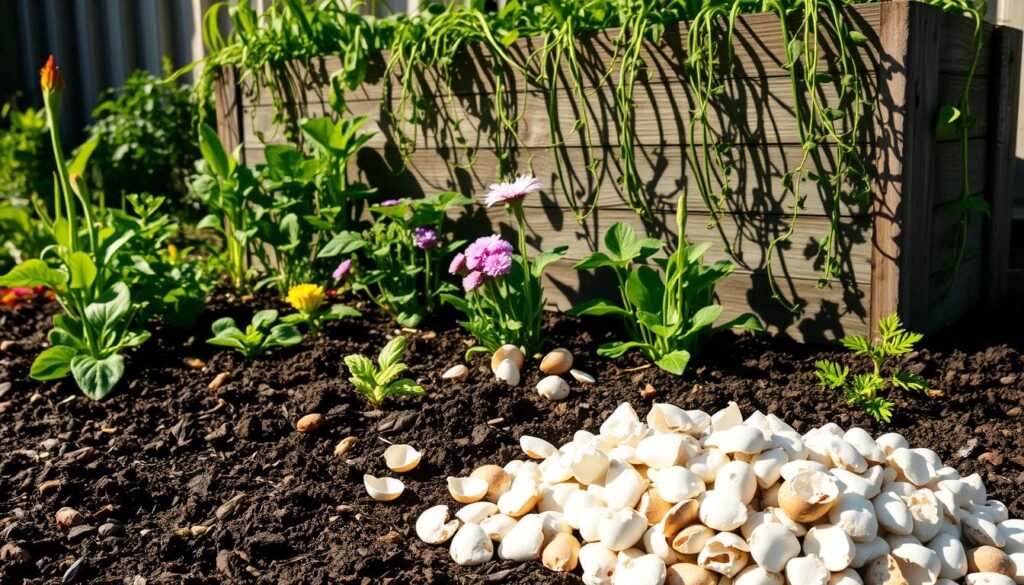
Using eggshell fertilizer to its fullest means mixing it with other organic stuff. This mix creates a blend rich in nutrients that plants love. It boosts soil health and keeps your garden balanced.
Banana Peel Power Combo
When you mix eggshells with banana peels, you get a dynamic calcium-potassium duo. This combo helps plants grow flowers and fruits. The potassium in banana peels helps with water and enzymes. Eggshell calcium makes cell walls strong. Here are some great mixes:
Nutrient Pairing Formula
| Material | Primary Nutrient | Secondary Benefit |
|---|---|---|
| Crushed Eggshells | Calcium (38%) | pH stabilization |
| Dried Banana Peels | Potassium (42%) | Disease resistance |
“Mixing banana peels with eggshell powder in my compost tea gave my roses 30% more blooms last season.”
Compost Tea Recipe
- Combine 1 cup eggshell powder with 2 chopped banana peels
- Steep in 1 gallon water for 48 hours
- Strain and dilute 1:4 before application
Coffee Grounds Alliance
Used coffee grounds pair well with eggshells, making a pH-balancing partnership. Fresh grounds are acidic, but eggshells neutralize it as they break down. This mix offers quick and slow benefits:
Soil Amendment Timeline
| Week | Nitrogen Release | Calcium Activation |
|---|---|---|
| 1-2 | High (from grounds) | Low |
| 3-6 | Moderate | Increasing |
Application Tips
- Mix 2 parts coffee grounds with 1 part crushed eggshells
- Apply as side dressing for blueberries or azaleas
- Replenish every 6-8 weeks during growing season
To get the best from your organic gardening, layer these amendments with mulch or clippings. This setup feeds plants and improves soil structure over time.
Seasonal Application Strategies
Using eggshell fertilizer at the right time is key. It matches plant growth and weather. This way, you get more calcium and help the environment.
Spring Preparation Timeline
Start early in spring to get plants ready to grow. Begin 4-6 weeks before the last frost in your area.
Pre-planting Soil Incorporation
Crush eggshells and mix them into the soil:
- Use 1 cup per 10 sq ft for veggies
- Work shells 4-6″ deep with a fork
- Add compost for faster breakdown
This stops blossom-end rot in tomatoes and peppers.
Seed Starting Mix Additions
Give seedlings a boost with eggshell powder:
- Bake shells at 200°F for 20 minutes
- Grind them into powder
- Add 1 tablespoon per quart of mix
This gives them calcium when they need it most.
Fall Soil Replenishment
Use eggshells in fall to get soil ready for spring. Do it before the first hard frost.
Overwintering Nutrient Release
Crushed shells break down slowly in cold soil:
| Month | USDA Zones | Application Activity |
|---|---|---|
| September | 3-5 | Top-dress perennial beds |
| October | 6-7 | Mix into vegetable garden soil |
| November | 8-10 | Apply around fruit trees |
Calcium is released slowly through winter.
Frost Protection Benefits
Eggshell mulch keeps soil warm:
- Protects roots from freezing
- Keeps slugs away
- Drains clay soils better
Use 2-3″ around roses and berry canes in winter.
Timing eggshell applications with the seasons boosts soil health. It also cuts down on waste. Check soil pH yearly for best growth.
Troubleshooting Common Issues
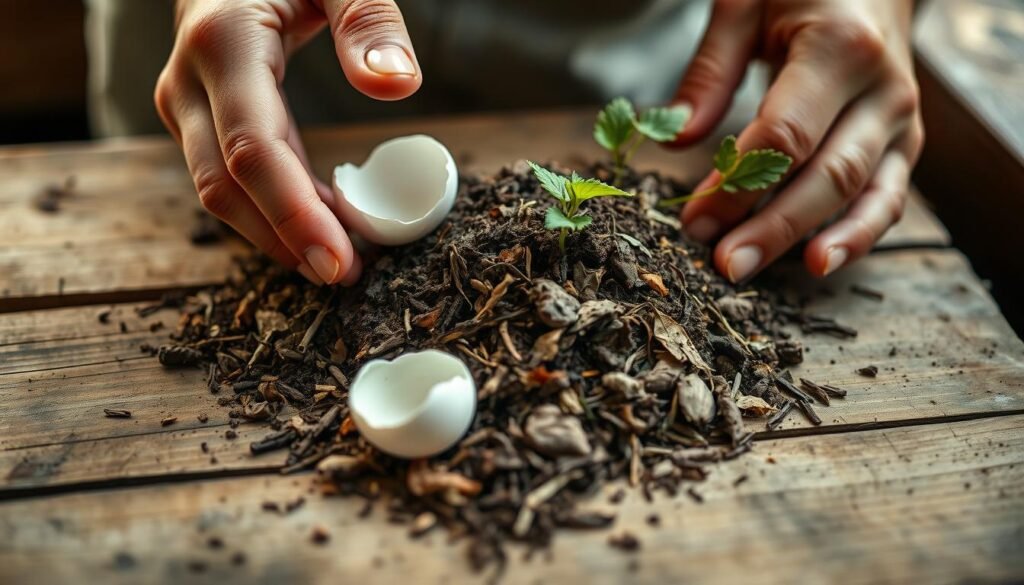
Even the best homemade garden fertilizer methods can hit snags. Let’s tackle two frequent challenges gardeners face with eggshell applications. We’ll give you science-backed fixes.
Slow Decomposition Solutions
Eggshells release nutrients gradually, but slow breakdown limits their effectiveness. Here are strategies to speed up the process naturally:
Particle Size Adjustments
Crush shells into powder using a coffee grinder or mortar. Finer particles (under 1mm) decompose 3x faster than coarse chunks. For bulk processing:
- Bake cleaned shells at 200°F for 10 minutes
- Blend in small batches
- Store powder in airtight containers
Accelerating Breakdown With Vinegar
Create water-soluble calcium acetate by mixing 1 cup eggshell powder with 4 cups white vinegar. Let the mixture bubble for 48 hours, then dilute 1:10 with water. This acidic solution:
- Works within days instead of months
- Prevents soil pH spikes
- Pairs well with liquid fertilizers
pH Monitoring and Adjustment
While eggshells buffer acidity, overapplication can raise soil alkalinity. Maintain balance with these techniques:
Testing Soil Alkalinity Levels
Conduct DIY soil tests every 6 weeks:
- Collect soil samples from multiple areas
- Mix with distilled water (1:1 ratio)
- Add baking soda – fizzing indicates acidity
- Use commercial test strips for precise readings
Balancing With Acidic Amendments
If pH exceeds 7.5, incorporate these counteragents:
| Amendment | Application Rate | Effect Timeline |
|---|---|---|
| Used Coffee Grounds | 1 lb per 10 sq ft | 2-3 weeks |
| Pine Needles | 2-inch mulch layer | 4-6 months |
| Elemental Sulfur | 0.5 lb per 100 sq ft | 6-12 months |
Always retest soil after amendments and adjust subsequent eggshell applications.
Embracing Sustainable Gardening Practices
Turning kitchen waste into garden gold shows how easy it is to help the environment. Recycling eggshells cuts down on landfill waste. It also gives plants a boost of calcium.
By using eggshells, gardeners can keep almost all of them out of landfills. This helps make soil stronger over time. It also means less need for harmful chemicals.
Begin by saving and rinsing eggshells each week. Use a blender or mortar to crush them quickly. Spread the powder around plants in spring or mix it into fall beds.
See better drainage in clay soils and more blooms in flowers soon. Share your success with others by swapping plants or composting together. Use simple test kits to check soil health. Every eggshell helps make the garden better, one seedling at a time.

